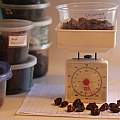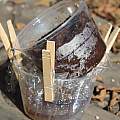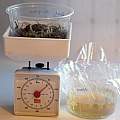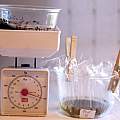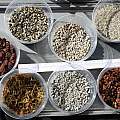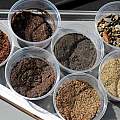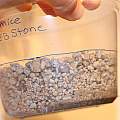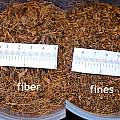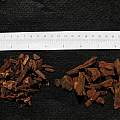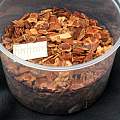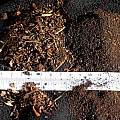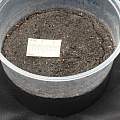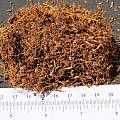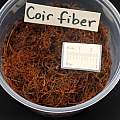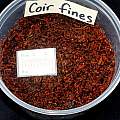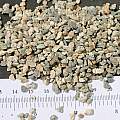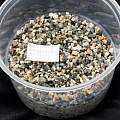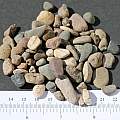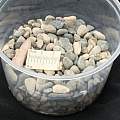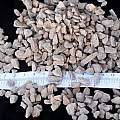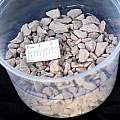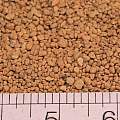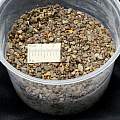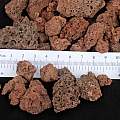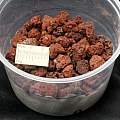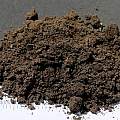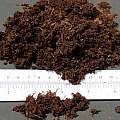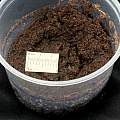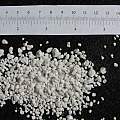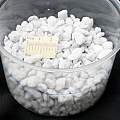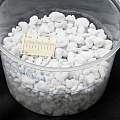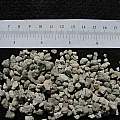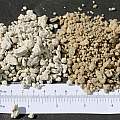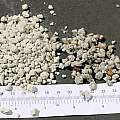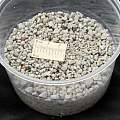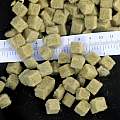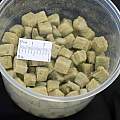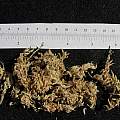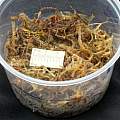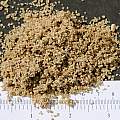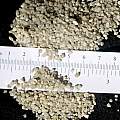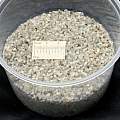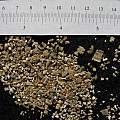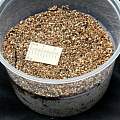This page discusses the growing media used in cultivation of bulbs.
On the PBS mail list, a discussion of potting mix written by Paul Cumbleton explains drainage and air space.
If you want to mix your own soil, keep in mind the amount of water retained by the ingredients you use. You want a mix that stays moist enough so that the bulbs' roots do not dry out, but not so wet that the bulbs themselves rot. If you're filling many pots, it's also good to keep in mind the weight of your potting mix, so you don't injure your back moving pots. Here's a chart of the characteristics of various commonly used ingredients:
Dry Density = weight of dry medium per volume of dry medium. (In other words, how heavy does it make your pots? Higher numbers are heavier.)
Water Retention = volume of water retained per volume of saturated medium. (In other words, how well does it store water for the roots? Higher numbers mean more water is stored.)
Air Filled Porosity = volume of air space after draining per volume of saturated medium. (How much air does it allow into the soil? In other words, how well-drained is it? Higher numbers mean better drainage.)
In general, ingredients that retain water well are poorly drained, and vice-versa. To get a good combination of water retention and drainage, you have to mix ingredients.
| Material | Dryness (applies only to Dry Density) | Dry Density, g/ml | Water Retention, ml/ml | Air Filled Porosity, ml/ml |
| bark, orchid seedling size | air dry | 0.21 | 0.15 | 0.64 |
| coir fiber, > 1/4 inch | air dry | 0.13 | 0.20 | 0.63 |
| coir fines, < 1/4 inch | air dry | 0.16 | 0.72 | 0.07 |
| compost, aged, sieved fines | air dry | 0.27 | 0.74 | 0.12 |
| granite chick grit | air dry | 1.34 | 0.13 | 0.28 |
| gravel, < 1/2 inch and > 1/4 inch | oven dry | 1.39 | 0.10 | 0.34 |
| GrowStone | air dry | 0.27 | 0.11 | 0.40 |
| kitty litter, Tesco brand | air dry | 0.55 | 0.43 | 0.23 |
| kitty litter, Jonny Cat brand | air dry | 0.69 | 0.37 | 0.16 |
| lava rock, crushed gravel | air dry | 0.81 | 0.15 | 0.52 |
| peat, Black Gold brand | slightly moist | 0.16 | 0.40 | 0.35 |
| peat, Black Gold brand | oven dry | 0.08 | na | na |
| perlite, < 1/4 inch | air dry | 0.09 | 0.22 | 0.37 |
| perlite, > 1/4 inch | air dry | 0.10 | 0.19 | 0.43 |
| perlite, unsifted* (powder at bottom of bag excluded) | air dry | 0.09 | 0.20 | 0.41 |
| perlite, unsifted* (with fines) | air dry | na | 0.62 | na |
| pumice, EB Stone, unsifted | air dry | 0.64 | 0.33 | 0.23 |
| rock wool, cubes | air dry | 0.05 | 0.53 | 0.41 |
| sand, silica #12 coarse | air dry | 1.47 | 0.23 | 0.21 |
| sand, horticultural | oven dry | 1.60 | 0.30 | 0.08 |
| sphagnum moss, Uni-grow | air dry | 0.02 | 0.18 | 0.70 |
| Supersoil, a commercial potting mix | na | na | 0.46 | na |
| vermiculite, non-horticultural, fine | air dry | 0.22 | 0.74 | 0.25 |
*See discussion of perlite below.
These measurements of water retention and air filled porosity were done in a simplified method by M. Gastil-Buhl, an amateur and are not a substitute for proven experience. Click on Method for details. A professional method is described in this pdf
Method
Measurements:
(1) Growing medium material was placed in a dish to fill 250 ml, a volume 9.0 cm diameter at the base and 3.2 cm high. (We realize container shape affects drainage, with a taller container draining more sharply.) Estimating volume of medium was the largest source of error. Dry medium was weighed. (The tare of the dish is subtracted from weights.)
(2) Water was added to just barely flood the medium, reaching approximately 1 to 2 mm below the 250 ml line, and soaked from 1 hour to 12 hours.
(3) Water was drained. Dishes were tipped at a 45 degree angle to facilitate draining. That affected how much water was retained. The drained water, or leachate, was weighed and assumed to be 1 ml per g. The saturated medium was weighed and its volume estimated by comparison to an empty dish with calibrated volumes marked. (Inorganic media tend to remain at constant volume but organic media tend to expand when wet and contract during draining.)
Calculations:
Dry Density = weight of dry medium / volume of dry medium
Water Retention = 1 ml/g * (weight of saturated medium - weight of dry medium) / volume of saturated medium
Air Filled Porosity = volume of leachate / volume of saturated medium
These five photos by M. Gastil-Buhl illustrate the method. The first photo shows the difficulty in measuring an exact dry volume with irregularly shaped lava rock pebbles as compared to the more easily measured volume of fine vermiculite particles in the second photo. The third photo shows the dish tilted to speed drainage. The fourth and fifth photos show the saturated, drained media being weighed and the variation in color and amount of leachate for moss and peat.
These four photos show a variety of particle size. The first photo includes saturated pebbles of lava rock, granite grit, pumice, moss, silica sand and orchid bark and in the second photo coir, peat, compost fines, vermiculite, horticultural sand and gravel after draining. Fine dust from pumice has settled at the bottom of the saturated pumice in the third photo. The fourth photo shows coir separated with a quarter-inch wire mesh into fiber and fines which have markedly different density, water retention, and air filled porosity.
Commercial potting mix varies tremendously from country to country. But in general, it's fair to say that pure potting mix is not recommended for growing bulbs in pots. It usually needs to be amended with sand or some other drainage-enhancer. Also, many commercial potting mixes break down after a couple of years, settling to the bottom of the pot as a powder that does not drain properly. So most bulb enthusiasts prefer to mix their own soils.
Bark can be used for growing geophytes such as Oxalis. However, certain types of bark such as the orchid bark below can be rather expensive. The first photo below by Nhu Nguyen shows two sizes of orchid bark. The second photo by M. Gastil-Buhl is orchid seedling size bark.
Compost may be the most variable material, varying in progress of decomposition and original materials composted. Well aged, sifted or sieved compost can be used in potting mix. The first photo by M. Gastil-Buhl shows home made compost aged over a year and sifted through a 1/4 inch mesh (left) versus sieved through a kitchen flour sieve (right). The second photo shows sieved compost saturated then left to air dry for 3 days. Original materials were shrub and grass clippings, kitchen scraps, dry leaves and wood shavings.
Coir is a product made from the husk of coconut fruits. In its ground form it resembles peat moss but there are a few differences. One major difference is that coir holds on to water very well and is not recommended for plastic pots in cool and wet places. Coir can also cause an allergic reaction in some people. Geophytes in terracotta pots in warm and dry places can be grown successfully using coir. Some growers avoid using this product while others have good results. If you decide to use coir, it is only good as part of a mix and all raw coir products should be washed at least once to remove salts (3x is best). Most growers that use coir suggest that the product be buffered with calcium sulfate (gypsum) and magnesium sulfate (Epsom salt) before use. Coir has both fibers and fines, with opposite properties for water retention and air filled porosity. The first, second and third photos by M. Gastil-Buhl show unsifted coir, coir fiber which does not pass through a 1/4 inch mesh, and coir fines which do pass through, respectively.
Diatomaceous earth also known as diatomite is a sedimentary rock formed from the fossilized remains of diatoms, a type of hard-shelled algae; chemically it is mostly silica. There are many applications, for example it can be used as a mechanical insecticide. The finest varieties from non-salt water sources are food grade, and used as an additive to control pests; less safe forms contain more crystalline silica. Used against insects with an exoskeleton, its action may be to dry the waxy protective covering or to lacerate. As a planting medium diatomite holds a lot of water whilst being difficult to compress and allowing air to penetrate. However it has been reported that it retains fertiliser salts and substantial rinsing is required to remove them.
Granite grit sold as Chick Grit (for poultry) works well as a top cover over seeds. But be aware that some brands of chick grit supposedly sometimes have salt in them. If in doubt, wash it before you use it. Photos by M. Gastil-Buhl.
Gravel can be used as a top mulch. It used to be advised in the bottoms of pots but that is no longer advised. The below photo is building gravel pebbles which all pass through a 1/2 inch wire mesh with an insignificant fraction passing through a 1/4 inch mesh. Photos by M. Gastil-Buhl.
GrowStone is manufactured from recycled glass for use in hydroponics. It has to be thoroughly rinsed before use. It comes in two size grades. The photos by M. Gastil-Buhl show the size grade labeled "super soil aerator" which all passes through a 1/2 inch mesh and only a small fraction passes through a 1/4 inch mesh. These have a smaller particle size than their other product labeled for hydroponic substrate. Cautionary note: leachate from growing media containing GrowStone was unusually alkaline 6 months after planting. Possibly even thoroughly rinsed material is only neutral on the surface. Broken particles may expose alkaline material.
Kitty litter - the last choice for a growing medium would be common 'clumping' cat litter, but some brands of 'non-clumping, lightweight' cat litter consist of fired (calcinated) granules of moler clay (a type of diatomaceous earth from Denmark), and provide a cheap way to obtain a material similar to Akadama, Turface and Seramis. It is heavier than perlite. First two photos by David Pilling of Tesco brand lightweight cat litter (Tesco own the US chain 'Fresh and Easy', do not confuse with an unrelated brand of cat litter with this name), third by M. Gastil-Buhl of Jonny Cat brand non-clumping clay kitty litter which is not as lightweight.
Lava Rock is sold for use as decorative mulch but can be used in potting mix. These photos by M. Gastil-Buhl show Quickcrete brand Red Lava Rock as bagged in the first photo, and crushed to smaller pebble size for potting in the second photo. Crushing creates dust, which was sifted off prior to testing for water retention and air filled porosity. The more precise term for lava rock is scoria.
Loam is dirt composed of about 40:40:20 percent sand:silt:clay. Loam soil drains well and is ideal for in-ground gardening. Perhaps not well suited as a growing medium in pots but a valuable component in raised beds or planting boxes. The below photo shows loamy sand with sand:silt:clay of 75:21:4 dug from the back yard of M. Gastil-Buhl. The dark color may be due to the high iron content.
Peat moss comes from peat bogs where sphagnum moss die and compress over thousands of years. It is a light and fluffy material that is low in pH. Peat stands out among growing media because it retains a fair amount of water (keeping roots moist) while allowing a fair amount of air to penetrate the soil (reducing rot and improving plant growth). Most ingredients either retain water or allow in air, but not both. Unfortunately, use of peat moss in gardening is controversial, because many people say its harvesting is not sustainable and causes irreparable damage to peat bogs, a specialized plant habitat. On the other hand, Canadian peat suppliers claim their harvest is sustainable. You'll need to make your own decision on whether you are comfortable with using this ingredient. Photos by M. Gastil-Buhl.
Perlite is like poprock, the mineral equivalent of popcorn. It is made from hydrated obsidian. When heated to 850-900 °C, water trapped inside the material expands and leaves behind pores in the rock when it cools. It is a versatile substance, lightweight, and holds water well. The sacks of perlite available in garden centers often contain a large amount of fines -- powdery perlite dust mixed with very small bits of perlite. These fines are very water-retentive and will clog up a soil mix, so bulb-growers who use perlite often sift it first, or buy pre-sifted perlite. Because of perlite's light weight, it tends to float in the pot when watered and heavy rain can wash the floating particles away. Some people also find the white perlite dust rather annoying to breathe in. It is available in several sizes. The first photo below by Nhu Nguyen shows a smaller sized perlite. The second, third and fourth photos by M. Gastil-Buhl show perlite which passed through a 1/4 inch mesh, did not pass through, and unsifted, respectively.
Pumice is a magical substance for growing geophytes. It is expanded volcanic rock which is formed naturally and is mined out of the earth. When used as a growing medium, it provides excellent drainage, holds just enough water, and dries out much quicker than other material. When dried, pumice particles change color making it easy to know when to water. For certain difficult to grow geophytes such as Worsleya, this material makes all the difference. I grow desert bulbs in pumice with 10-30% organic material in terracotta pots. The combination of this great material and the breathable terracotta works wonders in my rainy climate. It is often sold in bulk in feed stores under the name Dry-Stall (not to be confused with Stall-Dry). The first photo below by Nhu Nguyen shows both dry (lighter) and moist particles (darker). Where the pumice is mined determines its color and density. Two brands, dry and wet, are shown in the second and third photos by M. Gastil-Buhl. The fourth photo shows a wet sample of pumice used in the calculation of water retention and air filled porosity.
Rock wool is used in hydroponics and to grow orchids. It resembles fiberglass. Cut into centimeter cubes, it has the useful combination of high water retention and high air porosity, so it drains quickly but holds onto water. Being an inert material made from rock instead of organic matter, it does not break down.
Sphagnum moss is a bog moss which is excellent for holding water. It is available in long and short-fibered. Long fibered tend to be more expensive. New Zealand sphagnum is sustainably harvested. The first photo below by Nhu Nguyen shows New Zealand long-fibered sphagnum. The second photo by M. Gastil-Buhl shows the Uni-grow brand Premium Organic Green Moss.
Sand is often added to medium to provide drainage. There are many types and sizes. Very fine-grained sand is not recommended for bulbs because it doesn't allow air to circulate to the roots. But general-purpose construction sand is acceptable (if it is washed). River sand and "sharp" sand with variable particle sizes can work even better. The first and third photos below by M. Gastil-Buhl show sand sold as Horticultural Sand. The second and fourth photos show coarse (grade 12) silica sand which does not pass through a kitchen flour sieve.
Vermiculite is made from expanded basaltic material. It comes in several sizes and can look quite different but the identifying characteristic is that they all flake as apparent in the larger particles in the photo below. It holds water well, but tends to stick to everything and will compress after being in a pot for a while. The first photo below by Nhu Nguyen shows a smaller sized vermiculite. The second photo by M. Gastil-Buhl shows vermiculite manufactured by Thermo-o-rock. The bag does state "to be used as a soil amendment" but appears too fine to be horticultural grade.
